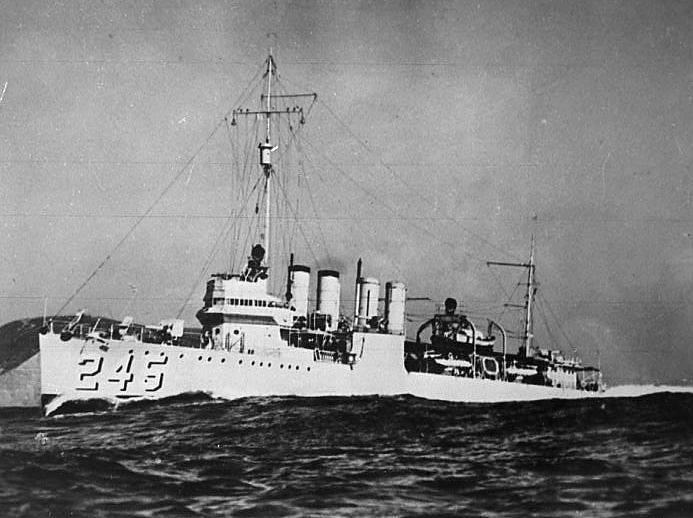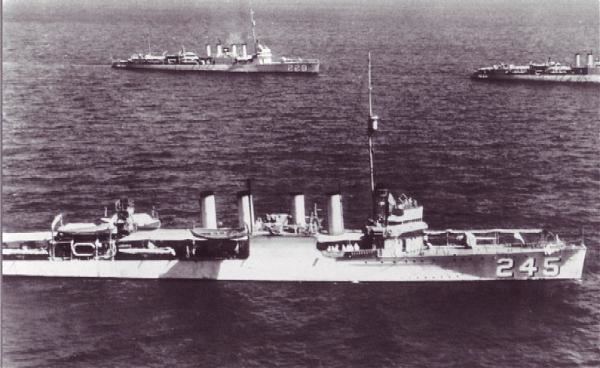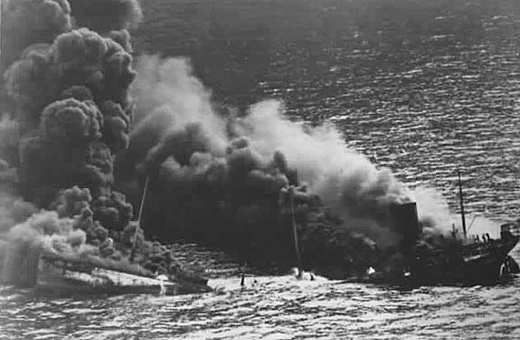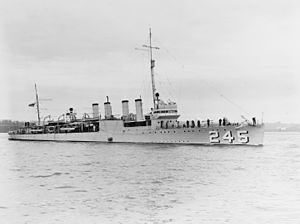Laid down 2 April 1919 In service 24 september 1920 Length 96 m Launched 4 October 1919 | Commissioned 24 September 1920 Out of service 31 October 1941 Construction started 2 April 1919 | |
 | ||
USS Reuben James (DD-245)—a post-World War I, four-funnel Clemson-class destroyer—was the first United States Navy ship sunk by hostile action in the European theater of World War II and the first named for Boatswain's Mate Reuben James (c.1776–1838), who distinguished himself fighting in the Barbary Wars.
Contents
Reuben James was laid down on 2 April 1919 by the New York Shipbuilding Corporation of Camden, New Jersey, launched on 4 October 1919, and commissioned on 24 September 1920, with Commander Gordon W. Hines in command. The destroyer was sunk by a torpedo attack from German submarine U-552 near Iceland on 31 October 1941.

Service history

Assigned to the Atlantic Fleet, Reuben James saw duty in the Mediterranean Sea in 1921–1922. Reuben James went from Newport, Rhode Island, on 30 November 1920, to Zelenika, Yugoslavia, arriving on 18 December. During the spring and summer of 1921, she operated in the Adriatic and the Mediterranean out of Zelenika and Gruz, Yugoslavia, assisting refugees and participating in postwar investigations. In October 1921 at Le Havre, she joined the protected cruiser Olympia at ceremonies marking the return of the Unknown Soldier to the U.S. At Danzig, from 29 October 1921 to 3 February 1922, she assisted the American Relief Administration in its efforts to relieve hunger and misery. After duty in the Mediterranean, she departed Gibraltar on 17 July.

Based then at New York City, the ship patrolled the Nicaraguan coast to prevent the delivery of weapons to revolutionaries in early 1926. In the spring of 1929, she participated in fleet maneuvers that foreshadowed naval airpower. She was decommissioned at Philadelphia on 20 January 1931. Recommissioned on 9 March 1932, the ship again operated in the Atlantic and the Caribbean, patrolling Cuban waters during the coup by Fulgencio Batista. She transferred to San Diego in 1934. Following maneuvers that evaluated aircraft carriers, Reuben James returned to the Atlantic Fleet in January 1939.
World War II
Upon the outbreak of war in Europe in September 1939, she joined the Neutrality Patrol, guarding the Atlantic and Caribbean approaches to the American coast. In March 1941, Reuben James joined the convoy escort force established to promote the safe arrival of materiel in Great Britain. This escort force guarded convoys as far as Iceland, after which they became the responsibility of British escorts.
Based at Hvalfjordur, Iceland, under command of LCDR Heywood Lane Edwards, she sailed from Naval Station Argentia, Newfoundland, on 23 October, with four other destroyers to escort eastbound convoy HX 156. At daybreak on 31 October, she was torpedoed by U-552 commanded by Kapitänleutnant Erich Topp near Iceland. Reuben James had positioned herself between an ammunition ship in the convoy and the known position of a "wolfpack", a group of submarines that preyed on Allied shipping. Reuben James was hit forward by a torpedo meant for a merchant ship and her entire bow was blown off when a magazine exploded. The bow sank immediately. The aft section floated for five minutes before going down. Of seven officers and a crew of 136 enlisted men plus one enlisted passenger, 44 enlisted men and no officers survived.
